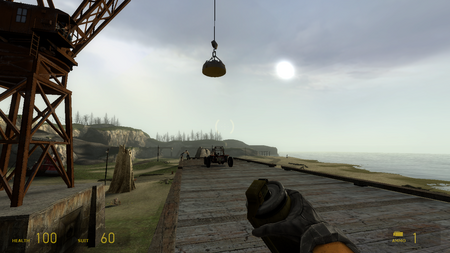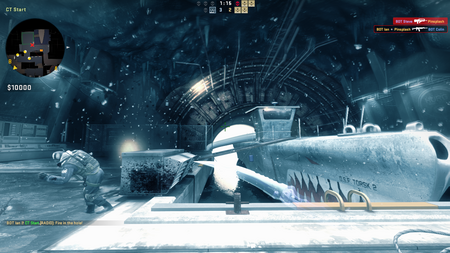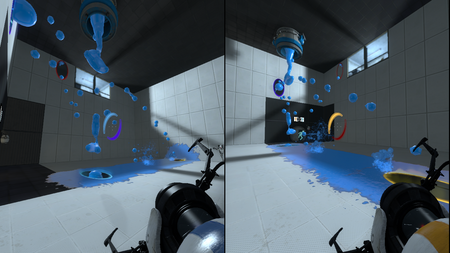Source
Jump to navigation
Jump to search




A complex scene from Half-Life 2. One human NPC operates a crane while one shoots another NPC with a mounted gun. The dune buggy is lifted by the crane before being dropped on the bumpy, uneven terrain below. There is also a glowing sun and water that seems to stretch forever, thanks to fog and a 3D skybox.

Another screenshot, from Counter-Strike: Global Offensive.

Portal 2 supports splitscreen, and can render convincing 3D blob particles that can morph together.
Source is a 3D video game engine developed by Valve Corporation. It debuted as the successor to GoldSrc with Counter-Strike: Source in June 2004, followed shortly by Half-Life 2 in November. Source implemented many new features and optimizations that GoldSrc did not have.
Rendering[edit | edit source]
- Bumpmapping.
- Phong shading.
- Moving lights.
- Water with refractions, realtime reflections, and flow maps.
- Advanced particle system that can emit sprites or models.
- Deformable terrain.
- 3D skyboxes extend the horizon and add parallax on distant objects.
- Static reflections.
- Cascaded shadow mapping.
- Cheap render-to-texture shadows make objects look like they occupy a real space.
- Effects such as smoke, fog and rain
Characters[edit | edit source]
- Characters that run, fly, jump, crouch, climb stairs and ladders, and burrow underground
- Eyes can move separately from heads.
- Support for many spoken languages.
- Battle AI allows squads of AI characters to operate together, know when to advance, retreat, lay cover fire, etc.
Physics[edit | edit source]
- Objects are free to move around in the world and rotate freely.
- Ragdoll physics.
- Vehicles, with individually simulated wheels. Vehicles have individually tunable parameters such as horsepower, gearing, max speed, shift speed, tire material, tire friction, spring tension/dampening etc.
Sound[edit | edit source]
- Digital Signal Processing.
- 16-bit wav standard.
- Textures can dictate how much sound they absorb.
Programming[edit | edit source]
- Mainly written in C++. Many games have their source code available publicly.
- Input/Output system allows level designers to control objects much more powerfully than before.
- Squirrel and Lua scripts offer even more complexity.